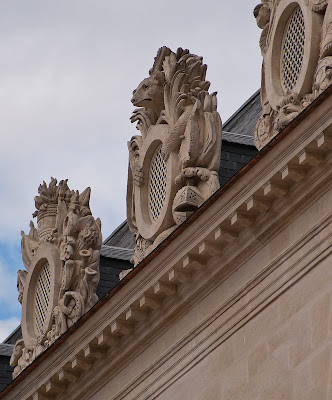"Meet me at the colonnade at the Palais-Royale..." Ominous words if you've seen the film "Charade" several times, as I have.
The Palais-Royale was built in 1639 as the residence of Cardinal Richelieu (it was then known as the Palais-Cardinal) and was later home to much nobility and royalty, including the young Louis XIV and his mother, Anne of Austria.
The Palais was undergoing a lot of renovation during my visit last year, so I went back to see how things were looking now. This was my first view of the striped columns that were installed in 1986 by a conceptual artist, Daniel Buren. They were controversial at the time, and I agree that they look out of place, though some people do like to stand on them, or lean against them.
I like the real columns!
...so much that I neglected to go look at the gardens in the back. I was curious to see the Galerie Vero-Dodat, which is nearby, and which I had seen in pictures several times. --It was looking a little empty, with a number of vacant shops; maybe it is the time of year...? However, I did see this gold peacock-like structure with a mirror for a head, which I assume you can acquire and have in your home:
I then headed over to the Tuileries, for another artsy shot, this time of people lunching under the trees:
Back to my walk...
You can see the Grande Arche de la Defense (which is worth a visit) in the distance, past the Arc de Triomphe.
I had another "Charade"-related destination -- the stamp market (marche au timbres)! It plays a large role near the end of the movie. I was fully prepared for there to be no stamp market, even though my guide books said it should be there (near the Palais de l'Elysee) on Thursdays.
So, here is half of the stamp market:
Someday soon I will visit the Petit Palais, but this wasn't the day for it. I went to see a "secret" garden that is just past the Grand Palais, at the corner of Roosevelt Avenue. Then, heading towards the Pont Alexandre, I admired this horse statuary:
And here is one of the women looking down from the bridge onto the many passenger boats passing below:
As an aside, I had recently taken a ride at sunset on one of these boats with a couple of friends who were visiting from Portland and staying in a hotel near me. We took the "Batobus", which had a stop near us. The disadvantage is that it makes a lot of stops, but that also means that you have more time to chit-chat and more time to admire some of the scenery at the stops, most notably the Tour Eiffel. For some reason, I neglected to bring my good camera, but a couple of shots from the phone camera cleaned up pretty well:
We did get to see a little bit of the on-the-hour flashing light show at the Tour, which was a good thing; Victoria and Shari said that otherwise, they would have assumed that I just made it up.
Back to the walk of the day: The Pont Alexandre provided additional dramatic horse-statuary photo ops!
Very dramatic! But it didn't rain.
I then proceeded to the Invalides, where my mission was to find two out-of-the-way items that are mentioned in the Metronome book and that I wanted very much to see... but I did not want to buy a ticket (not that day, anyway).
First, here is a nice shot of the building and dome, with flowers:
I succeeded in both of my missions! First, here is the original tombstone of Napoleon, from his exile on the island of St. Helena. Obviously, it bears little resemblance to the grandiose setup inside the building, his final resting place. It is tucked away by the side of the church, surrounded by bushes. You can see it through the glass as you walk down a hallway (This is pointed out in Rick Steve's guidebook as well as in Metronome-- credit where credit is due). I don't believe I saw any reference to it or any way to approach it.
My second target was in the Court of Honor, which was not even accessible due to some renovation or installation going on. I peeked in as far as I could, and my prize was right there, waiting to be photographed:
Louis XIV's minister of war, Francois de Louvois, oversaw much of the construction of the Invalides. As described in Metronome, he devised a clever way to get his name on the building: The animal you see above is a wolf, and he is intently looking out onto the Court of Honor: in French, le loup voit (the wolf sees), or Louvois. (Yes, there is also a photo in the book, but this is my photo!)
I did notice as I was walking past the tombstone, and as I was taking this photo, that a lot of people around me had audioguides around their necks, so I was probably in an area where you were supposed to have a ticket. Mission(s) accomplished, I walked out with no trouble.
I then headed though a long grassy area leading away from the Invalides, towards my chosen Metro stop. This was the (very large) median for the Avenue de Breteuil, and people were enjoying the day:
...I had definitely enjoyed mine!





















No comments:
Post a Comment